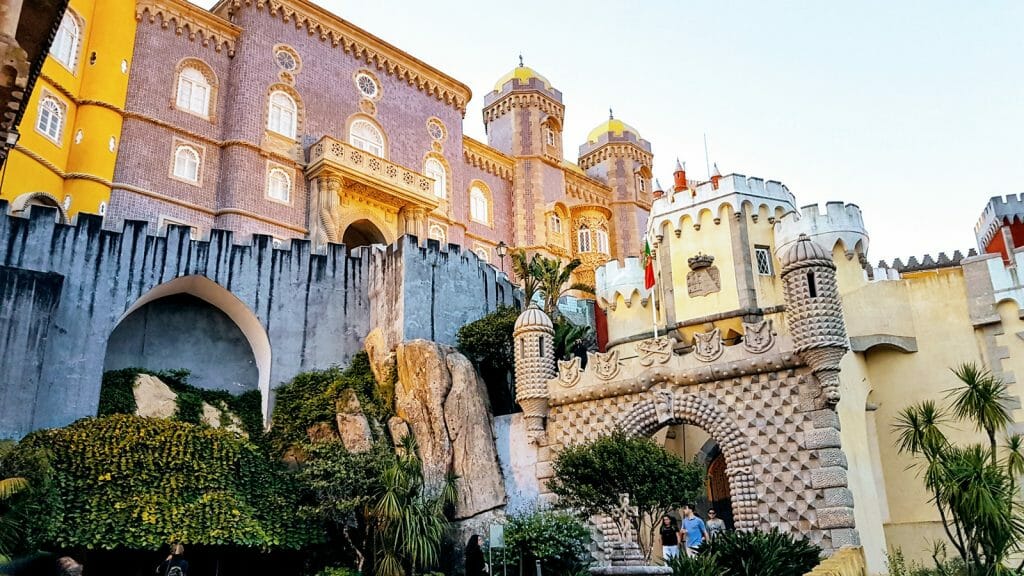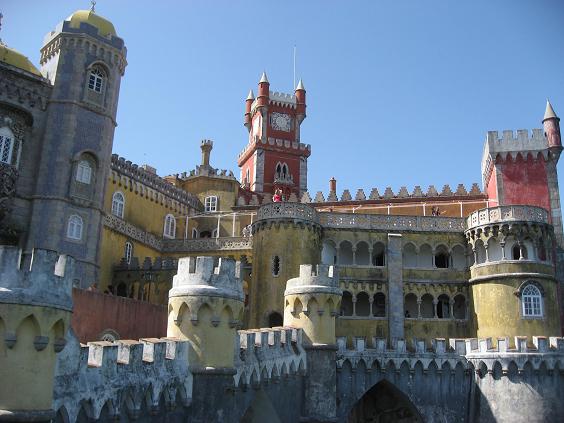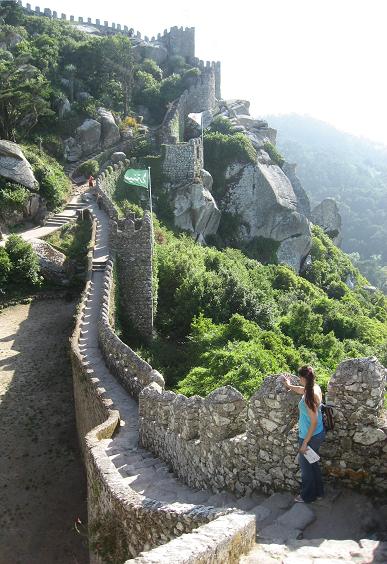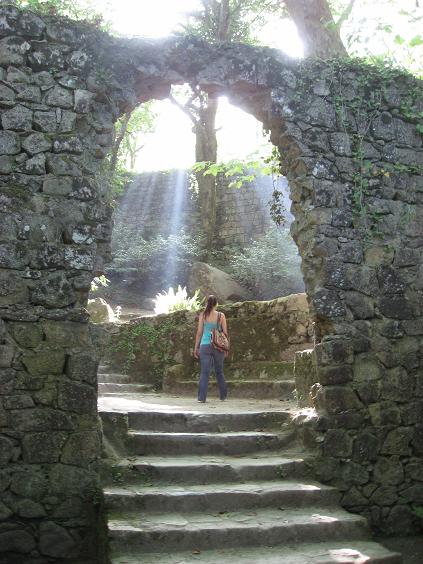The perfect weekend or day-trip destination from Lisbon for backpackers, café romantics, and families alike, Portugal’s Sintra offers its palaces, ruins, gardens, and squares to the explorer’s imagination. This historic UNESCO World Heritage Site is accessible from downtown Lisbon by a quick 10-mi/31-km drive or a more leisurely one- hour train ride.

The Sintra National Palace (Palácio Nacional de Sintra)
Arriving at the old town center, you will find that the Palácio Nacional de Sintra with its two massive chimneys rising behind a broad, white façade dominates the square. Though nothing built by the original Moorish rulers of the Middle Ages survives today, the palace’s primary structures reflect an Arab style.
Enter by the main entrance and make your way through the expansions constructed by Dom João I (1357-1433) and Dom Manuel I (1469-1521) during their reigns. Their namesake wings, Ala Joanina and Ala Manuelina, respectively, house the palace’s most unique rooms including the Sala das Pegas (the Magpies’ Room), the Sala dos Cisnes (the Swann’s Room), and the Sala dos Árabes (the Arab Room). Not to miss is the particularly impressive Sala dos Brasões (the Coats-of-Arms Room) featuring a domed ceiling elaborately decorated with the seventy-two coats-of-arms of the Portuguese nobility.
Because the Portuguese royal family affectionately inhabited the palace until the revolution in 1910, this national monument remains excellently preserved. The €4 admission (discounts available) is a bargain.
The Pena National Palace (Palácio Nacional da Pena)
Once back in the main square of the old town, look around for signs indicating the trail to the Palácio Nacional da Pena. The path, though not excessively steep, is a steady, uphill, hour-long walk winding through the lush flora of the Serra de Sintra (Sintra Mountains), part of the Parque Natural de Sintra-Cascais (Sintra-Cascais Natural Park).
I highly recommend the walk (both up and down) for its views of the traditional cottages and manor-like houses embedded behind their gardens and ancient walls along the way. If you prefer, taxis and a regularly running bus are available for a few euros.
One of the Sete Maravilhas de Portugal (Seven Wonders of Portugal), the Palácio Nacional da Pena evolved from a lone chapel constructed in the Middle Ages to an extraordinary fantasy of Romanticism at the hand of the Artist King, Dom Fernando II. In 1838, Fernando acquired the chapel, a small monastery, and the surrounding land and began to transform the site into the palace as it stands today.
Taking a keen interest in its every feature—from its drawbridges and turrets to the ornate windows he designed himself—Fernando delighted in the dramatic mixture of Islamic, Neo-Gothic, Neo-Manueline, and Neo-Renaissance styles. With its extravagant collections of artifacts, distinct fairy-tale colors, and spectacular location above the town, the Palácio Nacional da Pena is the premier attraction in Sintra. Admission ranges from €5 to €11.
Also worth exploring is the Parque da Pena (Pena Park). This large wooded area surrounding the palace contains Fernando’s inspiring selection of American, European, Asian, and Australian trees and ferns thriving alongside one another in Sintra’s subtropical microclimate. Admission included with a palace ticket.
The Castle of the Moors (Castelo dos Mouros)
Before returning to the town, stop at the first ticket booth you will have passed on your way to the Palácio Nacional da Pena. A short path to the Castelo dos Mouros will be near, just beyond an iron turnstile. Initially built between the 9th and 10th centuries, what stands is the result of ages of ruin followed by Dom Fernando II’s 19th century renovations.
Climbing the western end of the north wall and walking along its length presents remarkable views of Sintra and the Palácio Nacional da Sintra below and the Palácio Nacional da Pena above. On a clear day, you will be able to see Lisbon by looking east once you have reached the castle at the end of the north wall. Admission is 3.50€ with a variety of discounts available.
The nearby (and usually less populated) chapel standing in ruins, roofless though canopied by trees, is an excellent place to rest and have a packed lunch before descending the Serra de Sintra.
More in Sintra
Back in town, seek out Café a Piriquita just off the main square. Try a Queijada, a cheese-and-cinnamon tart traditional to Sintra, or a travesseiro (literally, “pillow”), a delicious jam-filled puff pastry. If you are in search of gifts or souvenirs, Sintra is known for its textiles and pottery and there are plenty of opportunities to window-shop while you snack. On a longer stay in Sintra, check out some of these other sights:
• Palácio de Monserrate (Monserrate Palace)
• Convento dos Capuchos (Monastery of Capuchos)
• Quinta da Regaleira (known as “the Palace of Moneiro the Millionaire”)
• Museu de Arte Moderna (Museum of Modern Art)
• Museu do Brinquedo (Toy Museum)
Take a look at these helpful guides about Lisbon:
Where to Stay in Lisbon – Best Neighborhoods and Hotels in Lisbon
Discover Lisbon with the Lisboa Card
Best Lisbon Food Tours and Cooking Classes
Written by Joseph Riley Pisari for EuropeUpClose.com




